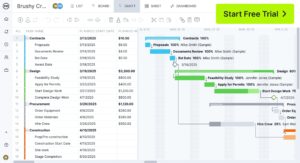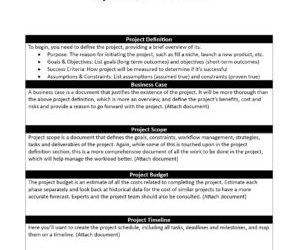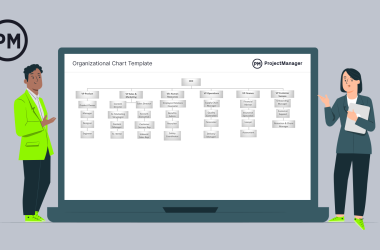Not all change is equal in a project. Some changes happen to you like weather delays, sickness—yet others are requested. Whatever the change, it must be managed and analyzed, then accepted or rejected. If the change is accepted, that is it must be responded to—which opens a whole new set of change control procedures to make sure you stay on track and within budget.
Change control is the process used to manage all these variables. If a change happens (which it always does) then it’s crucial that you have a mechanism in place to control that process. But what is change control in project management, and what are the steps necessary to implement it?
What Is Change Control?
Change control is a methodology used to manage any change requests that impact the baseline of your project. It’s a way to capture that change from the point where it’s been identified through every step of the project cycle. That includes evaluating the request and then approving, rejecting or deferring it.
The purpose of this process is to make sure that you’re not changing things in the project that don’t need to be changed. The last thing you want to do is disrupt the project for no good reason, wasting valuable time and resources. Any changes that are approved are then documented. The change control process is part of the larger change management plan.
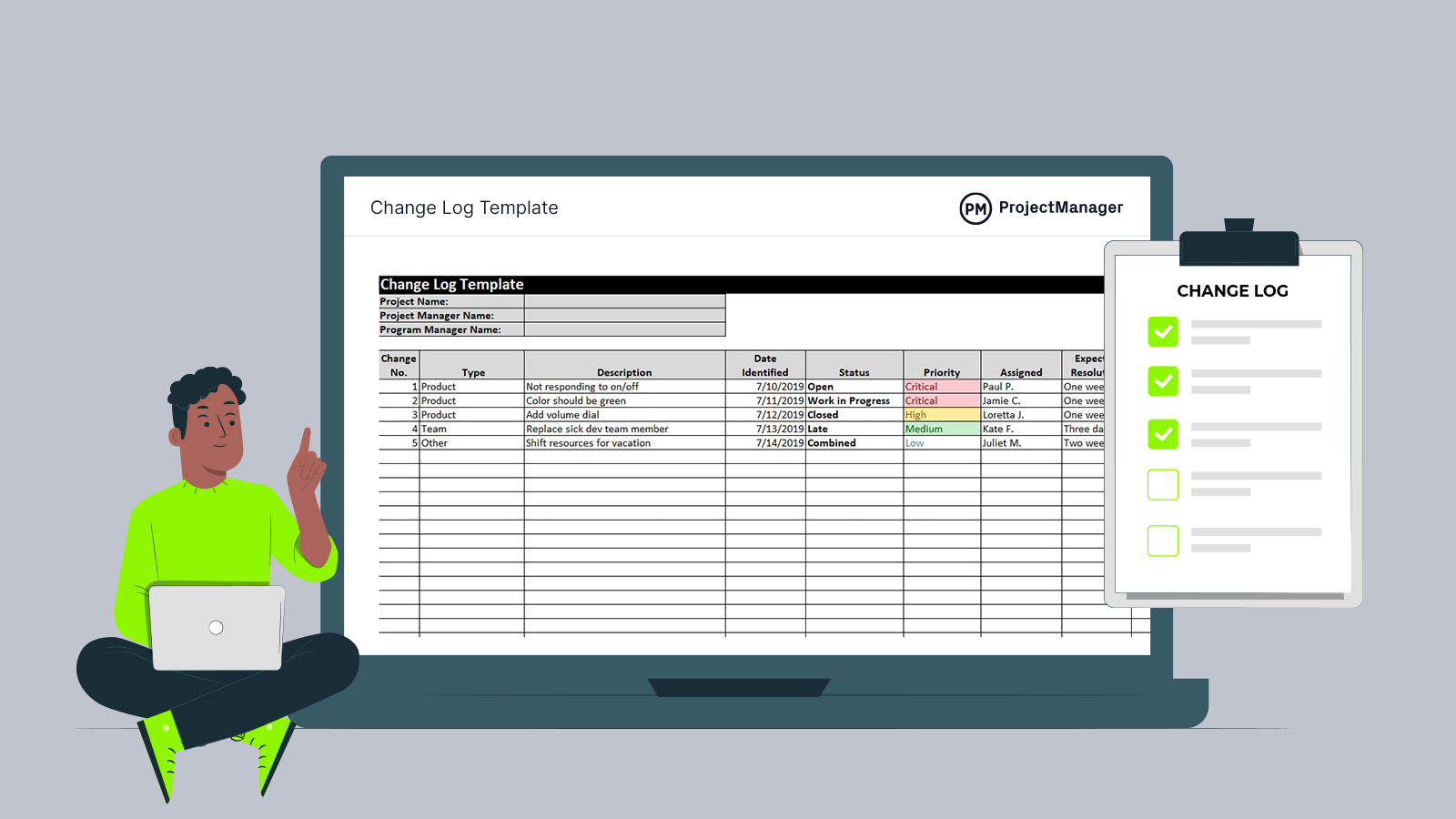
Get your free
Change Log Template
Use this free Change Log Template for Excel to manage your projects better.
Change Control Management
The term change control management refers to all the activities that are undertaken to set up a change control framework in a project, such as appointing a change control board, managing documentation and establishing a process for the evaluation of changes. Here’s a brief description of these key elements.
Change Control Standard Operating Procedure (SOP)
A change control standard operating procedure is the set of actions that employees of an organization or project team must take when submitting, evaluating and approving change order requests. This will vary from one organization to another depending on how rigorous the change control process will be and its risk tolerance, organizational structure among other factors.
Change Control Board
A change control board is a group of representatives from the project team that regularly meet to approve or disapprove change requests. If they approve a change request, it can turn into a change order.
Change Requests
A change request is a formal petition for change in a project. It’s a document that explains what are the changes to be made and the main reasons why they should be implemented.Change requests can either be submitted by internal or external project stakeholders. Our free change request template can help you streamline this process.
A change request is usually the trigger that starts the process of change management. The change request, also referred to as change control document or change control form, can originate from stakeholders asking for new features, the need to repair something that proves faulty during the execution phase, upgrades or any number of other causes. Whatever or wherever the change comes from, change control determines its value and how to feasible implement it.
Change Orders
Once the change control board has approved a change request, a change order is signed by the board and the clients or stakeholders.This is an agreement from both parties to change the conditions that were first drafted in the original contract. Our free change order template is a great tool to create your change orders.
Change Control Log
A change log is a change management tool that’s used to document all the changes made to a project plan or any contracts. It’s a must-have tool for any project manager.
What Is a Change Control Plan?
A change control plan is a document that’s typically used by project management offices (PMOs) to establish the standard operating procedures for change control. This guarantees that the same evaluation process is consistently followed for all change requests.
Change control comes in many forms, but the change control process is most effective when executed with project management software. ProjectManager allows you to capture the change in your project when you discover it on a task list, kanban board, Gantt chart or spreadsheet. Then manage that change with real-time dashboards and instant reports. Get started for free.
Change Control vs. Change Management
Change control is the first step of the larger change management process. It consists in receiving change requests from internal and external stakeholders of a project or organization and then evaluating them based on their potential risks, benefits and impact on the project plan.
The change control stage finishes once the change is approved or rejected, but the change management process continues with the execution of the change implementation plan. However, once completed, the change should be documented in the change control log.
What Is Integrated Change Control?
As defined in the project management body of knowledge (PMBOK), integrated change control is a process that consists in ensuring that implemented changes are properly documented.
This is done by adjusting the project plan, budget, schedule or any other project management form as needed and communicating those changes among the project team and stakeholders.
What Is Change Control Software?
Change control software allows organizations to plan, schedule and track changes. For example, ProjectManager is equipped with change control features such as unlimited cloud-based file storage so that team members across an organization can submit and access change order requests and collaborate online.
More importantly, ProjectManager allows users to make visual project schedules with Gantt charts and then adjust them whenever a change is made with a few clicks. Similarly, additional tasks, resources and costs can be added to a project using various project management tools such as kanban boards, task lists and calendars to seamlessly reflect any changes.
Then, you can use real-time dashboards and timesheets to monitor the progress, costs and timeline of the change implementation process.
5 Steps to the Change Control Process
By knowing the five stages of change control and what they entail, you can make sure your project and organization can reap the benefits and avoid the pitfalls of a bad change control process. While going through this process, keep in mind these two key documents (which we provide templates for!) to help you with managing your change control: your change log and change request forms.
1. Propose Change
The first thing to do is to identify the change. This can come from anyone on the project team, a stakeholder or even a customer. There must be a channel open for these suggestions to flow. The change proposal is submitted using a change order request form, which describes the change and how it would benefit the project or organization. If there are other reasons for the change, outline them on the change request form. That would then be added to the change log.
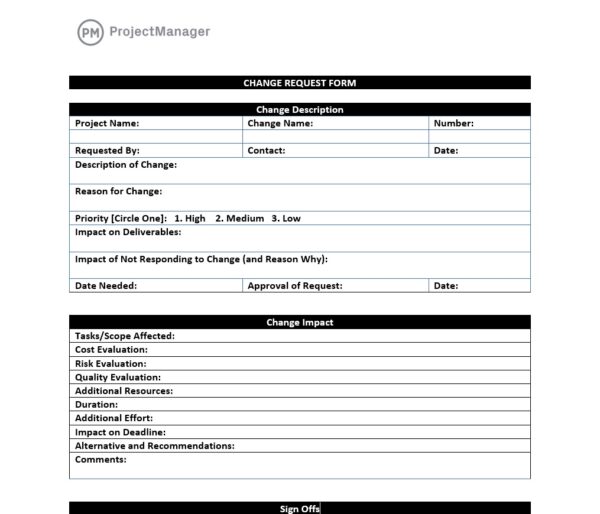
2. Change Impact Assessment
Once the change has been proposed, it’s now up to the project manager, the change control board and any other decision makers to consider it in the larger context of the project. How will that change impact a number of variables? The main objective is to determine what the potential benefits from the change are and whether those outweigh any potential costs and risks.
To determine this, you should ask yourself questions such as, how will the change impact your schedule? Will you need to employ more resources? What about other projects, and the overall business? Will the change bring new risks or issues to the project? Once decision makers have done the due diligence, they recommend that the change is either approved or denied.
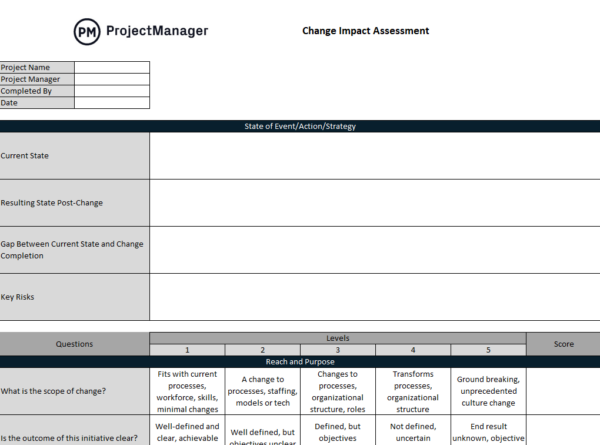
3. Change Readiness Assessment
Once the potential impact of the change has been gauged, it’s important to determine whether the organization is ready to implement the change based on variables such as strategic alignment, resource availability, capacity planning, resistance to change and many other factors. If the organization is not prepared for a change, its implementation could fail and therefore any potential benefits would be lost, but costs might still be incurred.
4. Making a Decision
The project manager makes the recommendation but is not always the authority to make the final decision on the change. Whoever that person or those persons are, the project manager will present their findings to them. Then, the person or persons authorized to make the decision will either accept the change; accept the change, but with notes and conditions; reject the change; or defer, which means the change will not be carried forward at this time but will be further deliberated on at a later date.
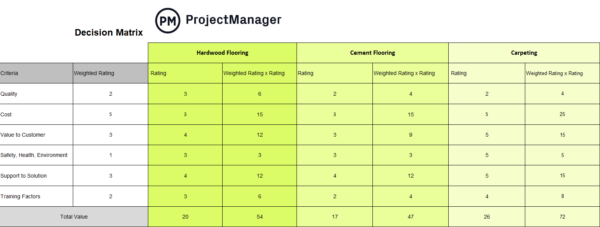
5. Implement the Change
If the change is not approved, then that’s status quo as far as managing the project. However, a change that has been accepted moves on to the planning stage. You’ll develop a plan of action, including a schedule with start and end dates, all of which must meet with the approval of the project stakeholders. The plan should include a regression test in case the change proves too problematic to follow through to the end and the project must revert to its original intent. After the change plan is completed, it’s usually followed by a post-mortem to review any mishaps and successes.

5. Closure
Just as in any project, the final phase of your change control plan is closing it up. This includes having the person who requested the change to oversee the final deliverable and make sure they agree with it. Once they have signed off on the change, then any outstanding paperwork must be completed, such as the change log, and filed away for future use.
Change Control Process Example
Let’s take a look at a hypothetical change in a project and go through the five steps that are part of the change control process. Take something as simple as painting a house. The client proposes a color change from the agreed-upon white to light green.
- The change is made during a meeting with the construction project manager, who creates a change proposal to capture the change.
- The construction team then looks into what impact the color change will have on the project. Did they already purchase the white paint, is the green paint more expensive, etc?
- After researching its impact, the project manager will make a decision. If going forward will impact the budget, then the client will be consulted.
- Once everyone is in agreement, the change is made. The new paint is purchased and applied to the construction.
- The client approves the paint job and any cost change, which brings this change control process to a close.
More Free Change Control Templates
Change control requires a lot of work. Templates can codify the change control process to make sure you’ve covered all the bases. ProjectManager is the premier online source for project management templates, which touch on every aspect of managing your work. Best of all, the downloads are all free. Here are a few free change management templates to try out.
Change Log Template
Once you’ve identified the change and have the approval to go ahead, you need a template that can track that change to make sure you’re staying on schedule. Our free change log template for Excel has all the details you need to monitor the change. From the type of request to the date identified, from the priority to its status, it’s all here for your change control process.
Change Order Form Template
The free change order form template for Excel helps you not only identify the change in your project but provide detailed information to put it in context. For example, you can note the opportunity that the change will provide to the work, describe the reason for the change, how long it’ll take and have a signoff from who requested and authorized it.
Project Dashboard Template
Managers and stakeholders are interested in that change you’re making to the project. They want to make sure it’s going ahead as planned and not negatively impacting the project. With our free project dashboard template for Excel, you can keep everyone updated. The free template creates graphs that show workload, costs and task metrics once you feed in the data manually.
What Are the Benefits of a Well-Executed Change Control?
If you know that there will come a point (or many points) in your project that requires a decision about some large or small change, then it’s safe to say that, as a project manager, you’ll want to have a process associated with this situation to ensure that the change is worth the effort. Then, you’ll want to have a way to manage the change to make sure it doesn’t negatively impact your project’s schedule and costs.
Managing change effectively is crucial to bringing in your project on time and within budget. But there are also unexpected benefits that come from change control. For one, it improves teamwork. Change is an opportunity for your team to work together to figure out how to respond to the change request. The teamwork involved in change control can be a boon to the productivity of the entire project.
Change control not only reinforces your team’s ability to work better together, but the positive effects bleed into overall efficiency. It works hand-in-glove with teamwork, of course. But the more you engage your team in change control, the more adept they become at solving problems quickly. This helps with the change, naturally, but will also make your team more effective in all their duties.
The team isn’t the only beneficiary of the positives related to good change control; managers are helped, too. Change control informs the project manager during the planning phase of the project. They will start thinking about change and how to better respond to it and learn from their experience with change control to put more safeguards upfront in their planning for future projects.
How Can ProjectManager Help Your Change Control?
Templates are a great way to get your change control process started, but software offers so much more. ProjectManager is an award-winning project and work management software that organizes risk, issues and changes within a project. Change control is really a sub-project of the larger project you’re managing. You need software with features to capture what might benefit from a change, plan for that change and then monitor and report on it. We can do all that and more, without you ever needing to leave our tool.
Track Progress of Your Changes
Change occurs for many reasons, but most of them are initiated by external forces. Keeping an eye on your project is one way to spot issues and respond to them before they become problems. Our real-time dashboard tracks several project metrics, calculates the data automatically and displays the results in colorful graphs and charts. Proper use of the dashboard could give you early signs about any issues with your project.
Collaborate on Change & Attach Documents
Once you’ve identified change, the next step is doing the work to determine if that change is worth pursuing or not. While the project manager will collect data and make a recommendation, the process can be facilitated by our collaborative platform. Everyone on the team has a space to comment and even attach documents and images related to the change. When the project manager has a recommendation, they can back it up to stakeholders.
Make Change Management Plans
If your change is approved, then comes the planning. We have an interactive Gantt chart that collects all your tasks and places them on a timeline once you’ve determined the duration of each. You can then link dependent tasks, set up milestones to break the project into phases and even assign from the Gantt. Teams can collaborate on their tasks and progress is indicated by the shading on the duration bar.
Related Change Management Content
Being prepared for planned and unplanned changes is key for success when managing projects and organizations. For that reason we’ve created dozens of blogs, templates and guides about change management related topics. Here are a few.
- 10 Free Change Management Templates for Excel and Word
- What Is Change Management? Principles, Process & Models
- How to Make a Change Management Plan
ProjectManager is a cloud-based software that manages project changes with features that help you on every step of controlling your overall project. Identify what needs to change, plan the change and then track its progress all with the same tool that you’re already on board to manage the larger project. Assume total control of project changes by taking this free 30-day trial.
The post What Is Change Control in Project Management? appeared first on ProjectManager.







